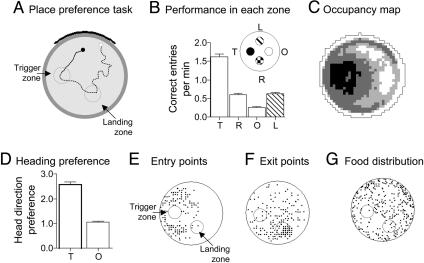Fig. 1.
Behavioral results. (A) A sketch of the place preference task. The rat must enter an unmarked trigger zone to release a food pellet from an overhead feeder. To eat a food pellet, the rat has to forage around the cylinder (solid line, navigation path to the trigger zone; dashed line, foraging path). In this example, the foraging path starts with an excursion into the landing zone (black dot, start of navigation path; white dot, end of foraging path). (B) Task performance in the trigger (T) and three control zones in adjacent right (R), opposite (O), and adjacent left (L) quadrants. (C) Overall occupancy map showing greater dwell times (dark pixels) in the trigger zone. (D) Index of heading preference toward the trigger (T) and opposite (O) zone. (E and F) Rat's positions before and after correct responses in the trigger zone used to calculate the entry and exit directions of the rat. (G) Food retrieval points.

